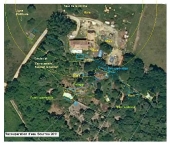dale hodgins wrote:
if you want to grow palm trees and watermelons a greenhouse will be absolutely necessary  .
. No, no such silliness. I do want greenhouses, but more for extended season than for daydreams. It's really not that difficult to heat up the ground and air, but unless I can grow electricity by planting light bulbs, providing for the light requirements of many temperate-climate plants can get either spendy or technologically very demanding. We're still working on this one. We hope to be able to develop a mixed-source off-grid electrical system, but that is very much in the searching stage.
You'll probably find that flattish sections of south facing slopes... The whole thing is pretty flat, very gently rolling, except the bank of the kettle pond which is about 30 feet high and has a sharp slope. I like the idea of early tilling to expose more soil to the spring sun, thanks. I don't know enough about hugelkultur to be able to say yes or no to your other suggestions, but I'm looking for information and will order some reading material very soon.
Strategically piled rocks... Wishful thinking. This area does not have big rocks. It does have lots and lots of little ones. It's a glacial outflow plain, left over from the last ice age. There are occasional orphan boulders (glacial isolates) that got dropped when the glaciers retreated, but if there are any on my land, they are deeply buried. Rocks can be had from the Chugach mountains which are not that far away, but the hauling costs are pretty prohibitive.
I wouldn't worry too much about negative aspects of completely clearing your fields. It breaks my heart to see all the dead spruce, but they will be put to good use. Because of crowding and shade, most of the birches are somewhat deformed with burls and interesting crotches. I do fine woodworking, and will be harvesting this "novelty" wood as we clear, for furniture building, bow and arrow making, and house trim. I believe that eventually I will leave the land better than I found it, which is really all anyone can hope for when using the earth's resources.
One big advantage with potatoes is that deer don't eat them. I've hidden other tasty edibles within a potato patch and not been bothered by deer. I've noticed that the moose don't bother potatoes, but will kill for broccoli. Almost literally - they will tear up fences and cold frames to get to those.
concentrate on difficult to obtain and expensive vegetable crops along with potatoes, cabbage and other cold tolerant staples. They'll show up for the tomatoes and then buy 50 pounds of potatoes on the way out the door 
That's what we are working towards. It's working in the area just inland and north of Anchorage (the Matanuska-Susitna Valley) where wonderful cold-weather veggies grow almost effortlessly. However, that area is becoming a bedroom suburb of Anchorage, and losing farmland at an alarming rate. Sad. And foolish. That is part of why we are moving to an area with little agricultural tradition, a bit south of Anchorage on the Kenai Peninsula.
The Greenland Norse were fixated on eating beef since that was the preferred food of the upper class. Sheep and goats are much more suited to northern climates but they were considered peasant food. This society devoted massive amounts of labor and resources to house cattle and feed them hay for nine months every year. During the summer when the men could have been hunting seal or walrus they put in huge amounts of time storing away hay for their skinny cattle. They also refused to eat fish which were abundant – some sort of phobia or religious taboo? I lived in Iceland for almost ten years, and I can assure you that there is no West Norse taboo against eating fish in any form including fermented (yecch). The Greenland Icelanders (they were three or four generations removed from Norway) kept cows because they believed that they needed milk. Sheep and goats do produce milk, but cow's milk is a staple in Northern Europe. They didn't fish as much as they really needed to because of a lack of boats as much as anything else. Even Iceland was suffering from significant decline because of deforestation that made them dependent on imported timber for boatbuilding. A viking without a boat is kind of like a biker without a motorcycle. And both the Icelandic and the Greenland Icelandic populations were pretty oblivious to the end of the Medieval Warming period and the onset of the Little Ice Age. This is not really a defense, but I hope a clarification. They kind of remind me of global warming naysayers.
And most importantly they refused to adopt any of the technology used by the Inuit people Again, sort of yes, and sort of no. I remember seeing a seal gut anorak used by Westfjords fishermen in Iceland, that is virtually identical to the anoraks used by Alaskan Native fishermen when fishing from kayaks, down to the construction of the stitches that hold the seal gut strips together. Borrowed technology or parallel development, the Greenland colonists did have the technology to survive, but they needed a belief system that allowed them to deal with the increasingly devastating cold. They didn't have that, and paid for it dearly.
I think I've gotten a bit off the topic of this thread, though, and will stop here. Thanks for your thoughtful answers.



























 1
1




 .
.

 1
1








 .
.










